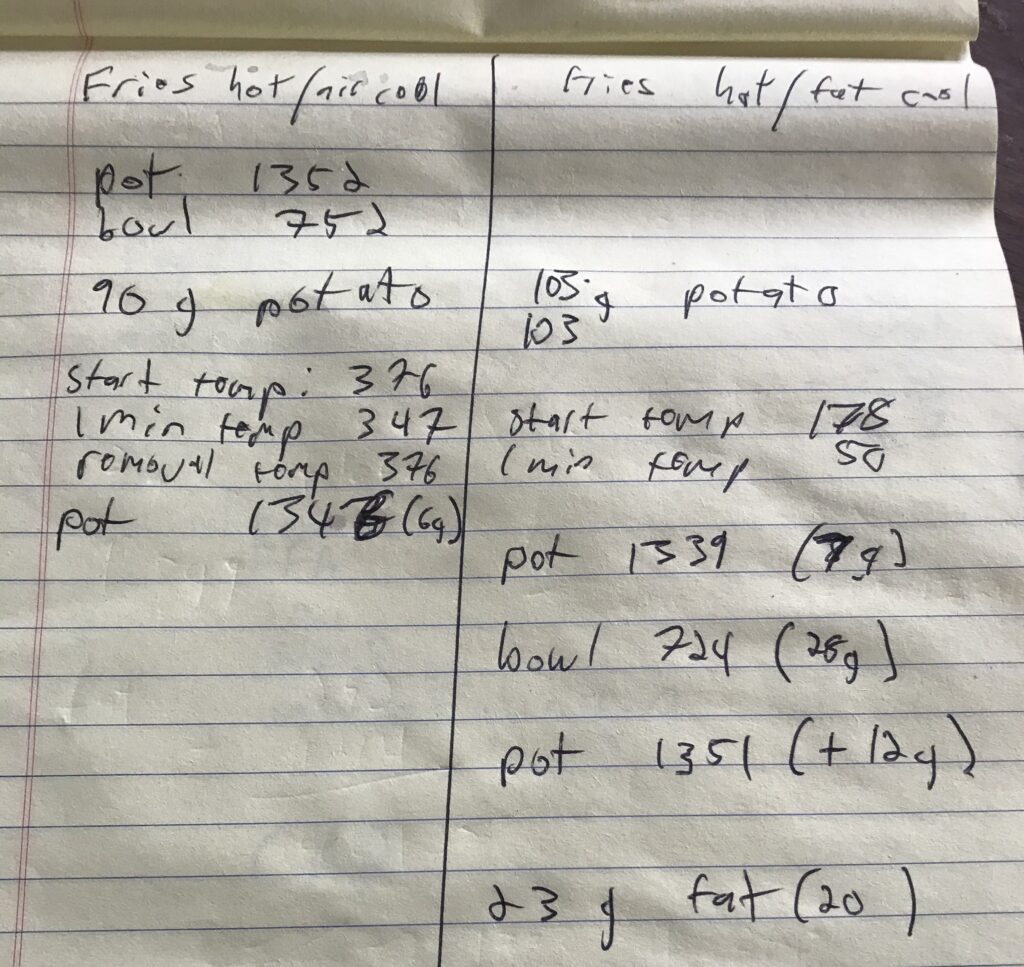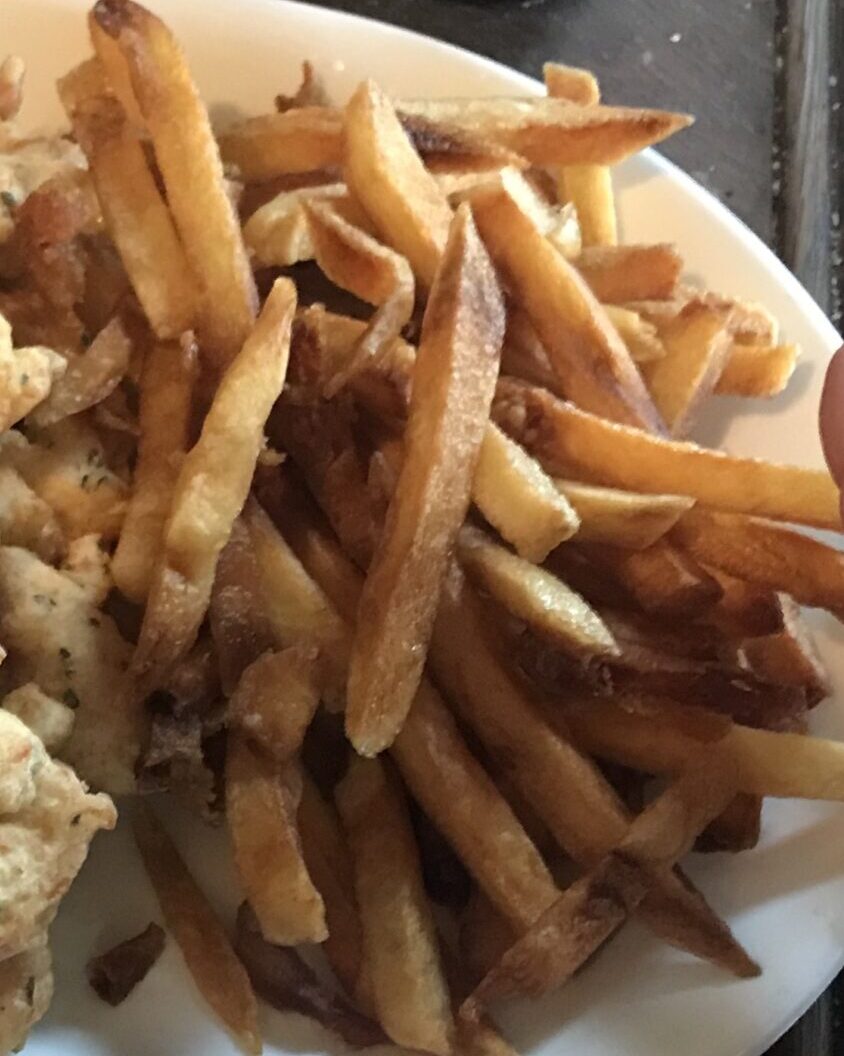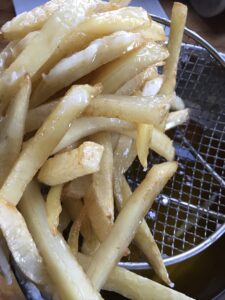It’s not by chance that I’m publishing this on July 23rd, 2020, 30 years to the day after McDonald’s announced they were switching from beef tallow to vegetable oil for their french fries. Here’s the thing though:
I found a way to double the beef fat content of french fries!
I suspect that most readers of this blog don’t eat a lot of french fries. Would you be more likely to if the ratio of fat to carbs was higher?
During the original Croissant Diet experiment, by the end I was just eating pancakes because they are the starch that absorb the most fat. The problem is that as I prepared for the Feasting Mimicking Diet I didn’t WANT to eat pancakes, I wanted to eat french fries. In all of my experimenting I’ve been disappointed at how little fat french fries actually absorb.
I started by cutting the fries small like McDonald’s fries to maximize surface area. I used the classic french technique of frying the potatoes once until nearly crisp, then chilling them for an hour to get the starches to gelatinize before quickly frying them a second time. The second frying makes the fries incredibly crispy but it also gives them a second opportunity to absorb the fat. Still, I could only get 26g of beef suet to absorb into 439g of starting weigh french fry cut raw potatoes. That comes out to a disappointing 42% of calories from fat and 52% from carbs. This is not the proper TCD ratio.
I tried frying them starting in cold oil. No luck. I tried making thin cut chips instead of fries. (UK readers heads are exploding right now. They thought we were already talking about chips.) Not much better. I tried making latkes – like McDonald’s hash browns – instead. Still no.
It was time to hit the literature. Sure enough1, it’s harder to get highly saturated fats to soak into fries than it is vegetable oil. But I found the secret2. “It turns out that fat uptake is basically determined by two mechanisms: the condensation effect and the capillary effect.”
When a deep fried item cools, the steam in it condenses, creating a vacuum that pulls surface fat into the inner starch via capillary action. Problem solved! Clearly then, all one had to do was cool the fries IN beef suet. That way, instead of drawing in surface fat and AIR they’d be drawing in all beef suet!

Look how well this worked:
So now 103g of starting weight potatoes absorbed a whopping 23g of fat!! But even if we assume that 3g of that fat was lost due to splashing of fat, dripping onto the plate, etc, 103g potatoes plus 20g of beef suet yields a fry that gets 70% of its calories from fat and a mere 27% from starch. Now we’ve got TCD ratios!
But how are they? They’re actually really good. They’re less crispy crunchy than the best fries but still quite crisp. The interior has more of a cakey texture. Overall they’re quite nice. Very satiating, though! Don’t try to eat too many.
I keep one bowl of fat whose only role is to be the fat to absorb into the fat bomb fries. This way it doesn’t pick up fryer oil flavors. Of course you have to melt the fat before you can cool the fries in it because you can’t dunk fries into solid fat. Just warm it low and slow and only until the last bits of suet have yet to melt, you want to be below 140 degrees or so.
This is admittedly a fussy way to make fries. But the good news is that you can do the pre-fry and dunk way ahead of time and then keep them in the fridge. They’ll cool into a suet block but they’ll come back apart again in the fryer. Before a meal just pop them into the fryer for a few minutes.
By the way, Malcolm Gladwell has a great history of the McDonald’s french fry at his podcast Revisionist History. Happy 30th anniversary, McDonald’s!

Ingredients
Equipment
Method
- Peel, then cut the potatoes. If you want to cut them ahead and fry them later, keep them submerged in water to prevent browning.
- Heat up the beef suet for cooling, slowly. This should be warm, so that it's melted, but not hot to the touch. It's OK if it looks a little milky, the fries will add some heat and it will clear.
- You can use an electric fry appliance in place of the pot if you have one. Otherwise, put the fry pot on high. When the oil is ready you'll see a whisp of smoke.
- Add the fires to the hot oil slowly. The water will cause the suet to bubble and potentially erupt if you add them all at once. You do NOT want to clean up a suet eruption, trust me.

- The oil temperature will drop and then slowly rise as the moisture is removed from the fries. When the fries start to brown, you may see some smoke as well as steam. It is time to dunk them.

- Dunk the steaming hot fries into the warm suet used a slotted spoon or a "spider". They'll wick up the oil like a candle wick.

- Drain the fries and allow them to cool. The longer they cool, the crispier they'll be. At this point you can refrigerate them for a week, probably longer.

- Finish the fries by frying them a second time. Do them in small batches to keep the oil temp from dropping. You want them to finish at around 350 degrees, at which point you'll steam and a little smoke. The fries are done when they are golden brown and crsipy. Enjoy!
- 1.Kita A, Lisi?ska G, Powolny M. The influence of frying medium degradation on fat uptake and texture of French fries. J Sci Food Agric. Published online 2005:1113-1118. doi:10.1002/jsfa.2076
- 2.Mellema M. Mechanism and reduction of fat uptake in deep-fat fried foods. Trends in Food Science & Technology. Published online September 2003:364-373. doi:10.1016/s0924-2244(03)00050-5

Nice. So do calories matter in terms of losing weight or the blunted insulin response???
How do we lose fat by eating more calories on tcd???
It’s magic. I’m kidding. I’ll be posting a VERY detailed results summary after two weeks with lots of data.
Overall I’m eating LESS calories but they’re packed into a shorter window. Basically, I’m combining ideas from The Croissant Diet, intermittent fasting and my own experience.
How long did you soak them in the warm suet?
Just a few minutes, they cool down pretty quick and soak it up almost right away.
Speaking of TCD ratios, do you have a particular macro ratio that you would recommend? I’m trying for at least 50% of calories from fat with about 30% carbs and 20% protein. I’m unsure if I should be eating more fat though.
That seems about right. In TCD I said a gram of fat per gram of starch, which is about double the calories from fat as from starch, but I think you might be fine at 50-30.
The traditional way to fry French fries (invented in Liege, Belgium, BTW) is in tallow.
Sadly, only high-end restaurants now do it this way.
You can easily get tallow here, but I wouldn’t know how to get suet. Are they interchangeable?
“Tallow” can refer to any beef fat. “Suet” is specific to the type of fat rendered out from the visceral kidney fat. Suet is more saturated than other types of fat on the cow.
I recently spent $40 on grassfed suet at the local farmers market, spent an hour rendering it and I’ve got a months supply easy. Directions here.
So, someone was selling suet by itself? I’ve rendered tallow a few times (easiest in a slow cooker, I’ve found), but I have a hard time finding the beef fat to render, and never see suet by itself.
I think suet is a specific type of fat, from which tallow is made.
In the US, how to people get tallow? I find it quite expensive, especially for frying.
Do I have to eat carbs with the fat in order to lose weight? The reason I’m asking is that I’m actually allergic to most carb items. Potatoes make me sick, I have Celiacs, and all grains make me sick as a dog (don’t want to go into detail). How can I eat this but maintain not eating grains or nightshades?
You don’t have to eat carbs at all. I initially started using them to prove to myself that the REAL problem isn’t carbs but in fact vegetable oil. Since then, I’ve learned that they are great for satiation due to the post-prandial blood sugar rise. If you want a toxin free source of carbs, consider a purified starch, such as cornstarch. It’s just starch! All plant proteins and toxins have been removed. I have a recipe for cornstarch and egg white pancakes that could also be used as a breading here.
This is amazing! More recipes please!
Side note: I found using the stearic acid enhanced butteroil when making croissants to be really difficult so I just used my Kitchenaid mixer to mix the same amount of stearic acid powder into butter. Do you see any issues with that?
Thanks for this site!
My only concern with not melting the stearic acid into another fat is with absorption. Straight stearic is not well absorbed. OTOH if you’re adding butter with SA powder into something that you’re then cooking, it’s prob fine.